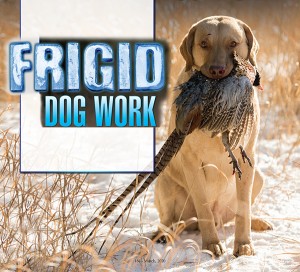Frigid Dog Work
Click here to read the complete article
Almost everyone who does any work with their dogs outside a temperature-controlled training facility and who lives north of the Mason-Dixon Line has had times when they were cold. Now by “cold,” I don’t mean the sort of namby-pamby cold that can be cured by a hot buttered rum, a cup of Irish coffee or by putting on a fisherman’s wool sweater. No, I’m talking about the kind of cold that no matter what you do, you can’t warm up, when your teeth chatter like castanets, when even your hair seems to shiver and you feel like there’s an icicle lodged in your core.
Those of us who have sporting breeds or hounds that actually hunt, or whose training needs to continue during the cold months in the case of sporting dogs, have on more than one occasion experienced this cold. It’s why most of the professional trainers in the northern tier states pack up and head for the southern border states shortly after the first frost arrives, with only a few brave souls postponing the journey until the Christmas holidays are past. But there are some who can’t flee the cold because of work demands or other constraints such as kids in school; and for these trainers and their clients, cold is an ever-present issue. It’s even worse when the tooth-rattling cold sneaks in during the hunting season.
Now I live in a northern border state known for rough weather although autumn is usually pretty moderate with decent weather conditions for both dogs and hunters. But a few years ago, October was more than chilly, November was miserable and December was remorseless. It was like all the talk about global warming had riled Boreas, the personification of the north wind in Greek mythology, to the degree that he was determined to show everybody that he hadn’t been deposed by Vulcan, the Roman god of fire.
Upland gamebirds aren’t much bothered by frigid weather. Pheasants, grouse, quail and partridge, as long as they have food and some conifers for shelter, get along just fine. Waterfowl, needing swimming water, lift off and head south long before cold weather becomes an issue with some, like the blue-winged teal, departing at the first hint that cold may be on the way. As long as they have the requisite number of calories and get some rest, the dogs also seem to thrive in the cold while their human partners physically slide downhill. For several months during that frigid year, I couldn’t seem to find a spot on my body that wasn’t numb or quivering every time I set foot outside the 70 degree atmosphere of my house. Trying to work with the dogs was miserable but hunting entered the realm of pure torture.
Click here to read the complete article
Short URL: https://caninechronicle.com/?p=179965
Comments are closed













